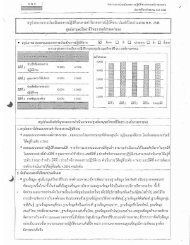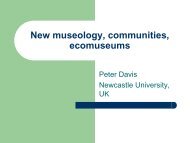Download
Download
Download
You also want an ePaper? Increase the reach of your titles
YUMPU automatically turns print PDFs into web optimized ePapers that Google loves.
“Ban Phu’s case demonstratesthat the preservation andrevitalization of local culturesoften have developmental ends—tourism, self-sufficiency economy,and local industry and business—that do not directly promote theconsciousness of cultural rights.”Cold War state policies. Ledby the understanding thateconomic development wasthe solution to the nation’ssecurity problems, the ThaiCold War state concentratedon rural developmentprograms, especially insecurity sensitive areasincluding Northeast Thailand.Ban Phu villagers actively joined government-initiateddevelopment projects. They worked closely with theCommunity Development Office in forming occupationalgroups such as weaving groups and handicraft-makinggroups. In the context of state-guided developmentalism,Ban Phu villagers embraced state development policiesas rural citizens and not as members of the Phu Tai ethnicgroup. Ban Phu’s invented lai kaew mukda woven silk, forexample, was promoted as a local product of Mukdahanwithout special mention of the Phu Tai wisdom or identity.It was only when the villagers started their tourism andhomestay project that they began to intentionally performtheir Phu Tai identity for the consumption of visitors fromoutside the community.The Ban Phu Homestay Project was launched in2007 with the support of the Nong Sung District CommunityDevelopment Office. Ban Phu’s visitors are mostly stateofficials and local administrative employees who comein groups for an educational tour to learn about BanPhu’s development and Sufficiency Economy Projects.The villagers welcome their visitors in Phu Tai traditionalclothes and serve a Phu Tai dinner accompanied bycultural performances such as music and dances. Thevillage’s products—hand-sewn Phu Tai-style shirts,sarongs, sin, hand-woven cotton shoulder cloths, andother handicrafts—are displayed for sale during theguest visits. The Ban Phu Homestay Project has provenprofitable; in 2007, Ban Phu’s total homestay income was1,856,660 baht.Culture as Rights or as Resources?Ban Phu’s case demonstrates that the preservationand revitalization of local cultures often have developmentalends—tourism, self-sufficiency economy, and localindustry and business—that do notdirectly promote the consciousnessof cultural rights. The promotionof the local culture industry,including tourism, contributes tothe revival of Phu Tai weaving,dress, and performances, butnot to all aspects of the Phu Taicultural heritage. The local schoolchooses to teach Phu Tai cookingand dance performances rather than Phu Tai languageas part of the local curriculum. Ban Phu villagers havealmost completely lost their ability to read the ancientLao Buddhist palm leaf manuscripts that the previousgenerations left them. Traditional yao healing practiceshave already disappeared from Ban Phu.Phu Tai Cultural Heritage and FutureProspectsA few possible actions can be taken to preserveand revitalize Phu Tai cultural heritage. Network andcoalition-building among the Phu Tai from differentvillages and provinces in Thailand as well as fromacross national borders would be an important step topromote and revitalize Phu Tai ethnic identity. Regionalscholars and cultural activists can play a leading role inbuilding and supporting a cultural rights movement andencourage the organization of ethnic minority groups inNortheast Thailand. The state should take an initiative toform a national policy that promotes the teaching of ethniclanguages in school and facilitate the revitalization ofscripts. These moves would increase chances for minoritycultures such as Phu Tai to survive into the future.ReferencesConnors, Michael Kelly. 2005. “Democracy and the Mainstreaming ofLocalism in Thailand.” In Southeast Asian Responses to Globalization:Restructuring Governance and Deepening Democracy, edited by FrancisLoh Kok Wah and Joakim Öjendal, 259–86. Singapore: NIAS Press.Piyamas Akka-amnuay. 2002. “The Phuthai People and Their PoliticalRoles on the Phu Phan Ranges During 1945–1980.” Master’s thesis,Mahasarakham University.







